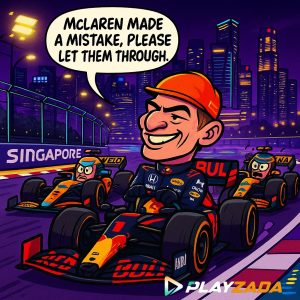Why the Singapore GP Matters for Verstappen’s 2025 Title Push
Why the Singapore GP Is the Litmus Test for Verstappen’s 2025 Title Charge
 Red Bull’s Revival Meets Its Toughest Track
Red Bull’s Revival Meets Its Toughest Track
After a mid-season dip that saw Red Bull trail McLaren, Ferrari, and Mercedes on outright pace,
a revised floor and a sharper understanding of the RB21’s operating window swung momentum back towards the defending champion.
Consecutive wins from pole in Monza and Baku have trimmed the deficit and reignited chatter about a fifth world crown for
Max Verstappen. Even so, Verstappen has been blunt: to flip the championship with seven rounds left,
he needs near-perfection—and a little luck elsewhere.
That’s why Singapore matters. Marina Bay’s high-downforce layout, relentless heat, and bumpy braking zones have historically exposed any
weakness in car balance, traction, and thermal management. It’s also one of the few venues where Verstappen has never taken victory,
making this race a genuine proof point for Red Bull’s resurgence.
Why Singapore Is the Real Benchmark
- High-downforce, high-drag demands: The car must generate grip at low speeds without cooking the tyres. Any imbalance shows immediately in sector times.
- Thermal stress everywhere: Ambient heat and stop-start acceleration punish power unit cooling, brakes, and rear tyre life—weak cooling packages pay a heavy price.
- Traction over kerbs: Marina Bay rewards compliant suspension and razor-edged rear grip. If the rear slides, tyre temps spike and lap time vanishes.
- Strategy complexity: Safety cars are common. Undercut/overcut windows are tight, and track position is king—qualifying and out-laps matter.
In short: a car that is quick at Monza’s low-downforce speeds isn’t automatically quick in Singapore. If Red Bull is genuinely back,
it should convert balance and tyre stability into one-lap supremacy and long-run control here too.
Verstappen’s Outlook: Cautious Ambition
Verstappen has framed the title picture soberly: he’ll do his part, but the math only works if results keep landing.
The tone from inside Red Bull is similar—encouraged by recent gains, yet keenly aware that Singapore has been a stumbling block.
Turning Marina Bay into a podium (or a win) would validate the development path and keep the pressure on championship rivals.
The champion’s strengths—tyre conservation, traffic management, and tempo control on worn rubber—are perfect for Singapore.
If the RB21 can hold rear grip across long stints, Verstappen’s racecraft tends to do the rest.
Rival Landscape: Why the Grid Won’t Make It Easy
McLaren and Ferrari have thrived on high-downforce tracks this season, while Mercedes has improved its mechanical platform on bumpy circuits.
Expect qualifying to be ultra-tight—front-row starts are priceless in Singapore given the narrow overtaking windows.
If Verstappen starts behind both McLarens or a Ferrari, the onus shifts to strategy: timing the pit window around a Safety Car and
protecting track position on the out-lap.
Keep an eye on long-run degradation on Friday. If Red Bull’s race sims show stable rears after 10–12 laps,
the team can dictate pace; if not, a defensive strategy and Safety-Car opportunism become essential.
Setup Keys: Where the RB21 Must Deliver
- Ride & compliance: Soften where possible to ride kerbs without bottoming; protect traction out of T3, T7, and the final sector.
- Thermal headroom: Open cooling and brake ducts enough for traffic running; overheating kills late-stint pace.
- Rear stability: A calm rear on entry prevents lockups and flat-spots—crucial for Safety-Car restarts and long stints.
- Quali trim vs race trim: Finding a balance between peak quali downforce and race-day tyre health is the whole game.
Strategy Map: How Verstappen Can Maximise Singapore
- Front-row priority: Build the weekend around qualifying—track position is the cheapest lap time in Singapore.
- Safety-Car readiness: Keep an undercut in pocket, leave tyre life for a push lap when the neutralisation ends.
- Overcut insurance: If stuck in a DRS train, extend first stint to attack clear air; Red Bull’s tyre life must support it.
- Clean pit execution: The pit lane is tight and busy—0.3–0.4s in the box can be the difference.
Bigger Picture: Title Math & Momentum
With seven races left, every podium swing matters. Singapore is less about raw points and more about signal value:
if Red Bull translates its Monza/Baku form to Marina Bay, the paddock narrative shifts from “track-specific bounce” to “full-field parity or better.”
That psychological momentum can influence rivals’ risk appetite at the next rounds.
Conversely, if Red Bull slips back here, the uphill climb steepens and Verstappen’s “need everything to be perfect” mantra becomes literal.
Quick Resources & Safe Play
Follow official timing and standings via Formula 1 and
FIA.
If you’re wagering on race markets, keep it fun and controlled—see
Responsible Gaming for tips.
Explore more motorsport and sportsbook insights on our blog’s sports hub.
Verdict: Marina Bay Will Tell Us Everything
Verstappen doesn’t need hype—he needs a clean weekend that proves Red Bull’s gains travel from low-downforce flyers to
Marina Bay’s heat and hairpins. If the RB21 is planted over bumps, gentle on rears, and quick in quali,
the championship door stays open. If not, the climb becomes Everest-steep. Either way,
Singapore will turn speculation into evidence.
18+ only. Please play responsibly. Markets may vary by region.
Check local regulations and stay in control.

